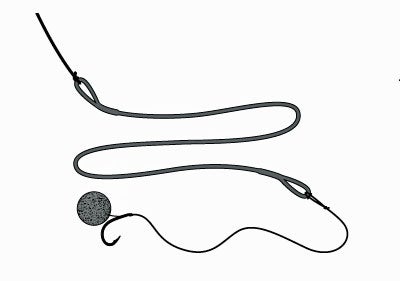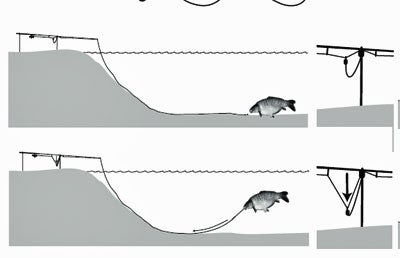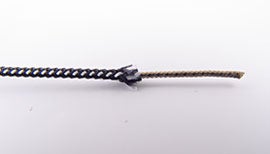Alternative Lead Core Tactics by Dave ChiltonLEAD CORE HAS been around for years but surprisingly its full potential has not yet been realized. Ask a stereotyped angler what lead core is used for and more often than not the reply is, “It’s for the length behind the bomb.” The truth however, is that lead core offers numerous applications and when applied in the correct manner can turn a blank day into a success. Below are a few examples of how to maximize the product and dramatically improve your presentation. All of these methods are proven fish catchers used by myself over the years; consider them as another string to your bow. Be aware that these methods can only be effective when using a substantially weighted lead core line; the more common lightweight lead cores on sale are simply not up for the job. Warning. Never use lead clips or tail rubbers with lead core. Due to the increased diameter the spliced section could jam fast in the narrow sleeve to create a tether rig. With all lead core rigs always ensure the hooklength can run free before casting. Lead core as a lead weightControlled free lining
Connect mainline and hooklength to each end of the splice. Unlike a bomb Score’s splash free entry does not tend to spook cautious feeders as it lands more like a fly line. Cast out, feather the line and let it settle. Now gently tighten leaving a small amount of slack. Once a fish inhales the bait and lifts the first few inches of core off the bottom an immediate bite will register. Depending on contours of swim and angle of main line two types of indication can be expected. Rod tip to deeper water 6 feet or more (see illustration) more often than not a drop back. Rod tip to shallow water, slow steady rise of indicators, fish does not bolt.
The reason why this method is so successful is that the fish are not alarmed by the slow gradual increase in weight when picking the bait up. Unlike a bolt rig there is no sudden jarring as the hooklength becomes fully extended. As we know wary fish are aware of problem baits. Instead of panicking and bolting they stay in situ trying to shake the hook free, often without raising a single beep. As the fish levels itself out more of the lead core is raised off the bottom. The weight gradually increases but only in tiny increments. Once it starts to move even the tiniest pinprick holds due to the continuous sustained drag the core has created. As the indicators rise and the spool slowly rotates often the fish moves on blissfully unaware that the trap has been sprung. The beauty about this method is that your mainline is placed a considerable distance from the hookbait. The longer the length of lead core used the greater the distance is put between your mainline and bait. As your mainline rises through the water to your rod tip there is little chance of fish touching it. Anyone who has fished for barbel or carp in clear water knows how easily they spook once they touch the line. This style of angling is pure retro. Carp fishing began with free lined baits. The technique of weighted free lining blends the old with the new and on its day can be devastating due to its simplicity. What’s more, you will enjoy the fight far more using bomb-free gear. Should extra distance be required for mid range simply add a small stringer or PVA bag. This method gives controlled free-lining at close to medium range without sacrificing presentation. Regarding PVA bags I must mention Nick Helleur’s excellent tip to make bags sink instantly. Bags float or sink slowly because of the trapped air that surrounds each bait or particle. To remove the air simply sprinkle dry sand into the bag and continually tap it down. The sand will find its way into every nook and cranny removing the air as the level builds up. Add more sand until it reaches the top then tie it. The bag is now airless and very eco friendly. Being much heavier it cast further and instantly plummets like a stone. When fishing over dark mucky silt the bag will deposit the sand leaving a nice clean light patch with your irresistible choice of bait sat on top, just like a dining table. Brilliant. River fishing
Instead try this. Cast a length of lead core into midstream. By raising and lowering the rod tip you allow the current to sweep the rig in under the trees branches or rafts. Once in place lower the tip and get ready for action. You can literally place your bait on the noses of the fish. By experimenting with different lengths of lead core you will soon be able to match the length required to the speed of the current for that particular swim. Carry different prepared spliced lengths with you to cover most swims slow or fast. For extremely strong water I will use as much as 3-4 meters to combat the flow. By attaching individual spliced lengths using the loop-to-loop method you can quickly have a tailor made length in next to no time without breaking down the whole of the terminal tackle. Float fishingFloat fishing lift method style. Instead of using shot where the weight is concentrated in one spot try a short length of spliced lead core (8-10cms). Because the mass is stretched out the hookbait descends more slowly through the water. When fished overdepth finicky fish feel no immediate weight as the core is lifted. Even when as little as one centimeter is raised from the bottom an immediate indication of the float can clearly be seen. When bites tail off as the early morning sun climbs this extremely sensitive method often prolongs catching hours. Do give lead core a try and not just behind the bomb. The amount of times fish swim between your rod tips and your bait without betraying their presence is amazing. Good Luck, may your slack lines soon become tight. Dave Chilton |
Welcome!Log into your account













